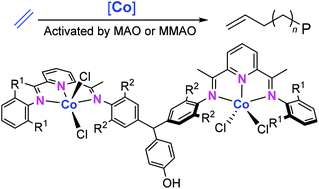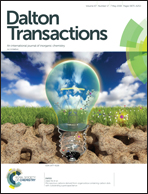Methylene-bridged bimetallic bis(imino)pyridine-cobaltous chlorides as precatalysts for vinyl-terminated polyethylene waxes†
Abstract
Four examples of phenol-substituted methylene-bridged bis(imino)pyridines, CH(C6H4-4-OH){2′-(4-C6H2-2,6-R22N![[double bond, length as m-dash]](https://www.rsc.org/images/entities/char_e001.gif) CMe)-6′-(2′′,6′′-R12C6H3N
CMe)-6′-(2′′,6′′-R12C6H3N![[double bond, length as m-dash]](https://www.rsc.org/images/entities/char_e001.gif) CMe)C5H3N}2 [R1 = R2 = Me L1, R1 = R2 = Et L2, R1 = Et, R2 = Me L3, R1 = iPr, R2 = Me L4], have been synthesized and fully characterized. Treatment of L1–L4 with two equivalents of cobaltous chloride affords the bimetallic complexes, [(L)Co2Cl4] (L = L1Co1, L2Co2, L3Co3, L4Co4), in good yield. The molecular structure of Co1 shows the two metal centers to be separated by a distance of 13.339 Å with each cobalt displaying a distorted trigonal bipyramidal geometry. On activation with either MAO or MMAO, Co1–Co4 exhibited high activities for ethylene polymerization (up to 1.46 × 107 g(PE) mol−1(Co) h−1 at 50 °C) with their relative values influenced by the steric properties of the N-aryl groups: Co1 > Co3 > Co4 > Co2. Highly linear polyethylenes incorporating high degrees of vinyl end-groups are a feature of all the materials produced with the molecular weights of the MAO-promoted systems (Mw range = 2–8 kg mol−1) generally higher than seen with MMAO (Mw range = 1–3 kg mol−1), while the distributions using MMAO are narrower (PDI < 2.0).
CMe)C5H3N}2 [R1 = R2 = Me L1, R1 = R2 = Et L2, R1 = Et, R2 = Me L3, R1 = iPr, R2 = Me L4], have been synthesized and fully characterized. Treatment of L1–L4 with two equivalents of cobaltous chloride affords the bimetallic complexes, [(L)Co2Cl4] (L = L1Co1, L2Co2, L3Co3, L4Co4), in good yield. The molecular structure of Co1 shows the two metal centers to be separated by a distance of 13.339 Å with each cobalt displaying a distorted trigonal bipyramidal geometry. On activation with either MAO or MMAO, Co1–Co4 exhibited high activities for ethylene polymerization (up to 1.46 × 107 g(PE) mol−1(Co) h−1 at 50 °C) with their relative values influenced by the steric properties of the N-aryl groups: Co1 > Co3 > Co4 > Co2. Highly linear polyethylenes incorporating high degrees of vinyl end-groups are a feature of all the materials produced with the molecular weights of the MAO-promoted systems (Mw range = 2–8 kg mol−1) generally higher than seen with MMAO (Mw range = 1–3 kg mol−1), while the distributions using MMAO are narrower (PDI < 2.0).



 Please wait while we load your content...
Please wait while we load your content...